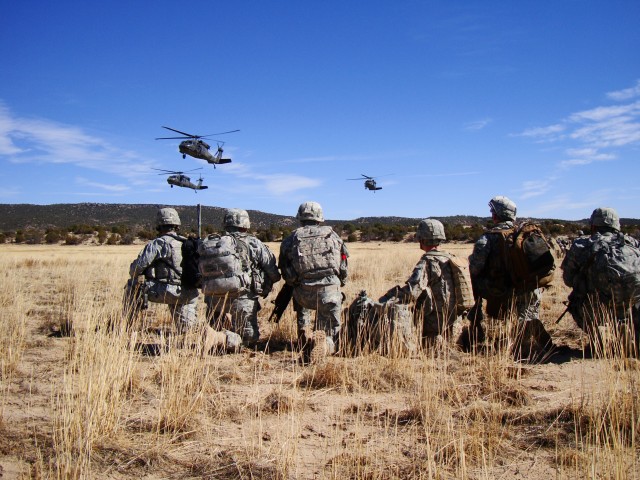FORT CARSON, Colo. -- When a 1st Cavalry Division aviation unit came to Fort Carson for high-altitude training to prepare for its deployment to Afghanistan, it needed the assistance of ground troops to make training as realistic as possible.
Leadership from 4th Battalion, 227th Aviation Regiment, 1st Air Cavalry Brigade, 1st Cav. Div., Fort Hood, Texas, called on Company D, 1st Battalion, 12th Infantry Regiment, 4th Brigade Combat Team, 4th Infantry Division, to get the most out of its training at the Mountain Post Feb. 10 and 16.
"Dog Company" and other 1st Bn., 12th Inf. Reg., Soldiers spent two days conducting air assault operations in support of 1st Cavalry's aviation unit. Soldiers had the chance to be part of a rare and valuable operation that required precise coordination between two very different branches of the Army.
"There is not a simulator that can replicate the sinking feeling that a private gets in his stomach when a CH-47 lurches into sky. There is no trainer that makes a lieutenant's voice tremble the way it does when he is calling for live rockets from an AH-64 Apache flying 100 feet over his shoulder. There has never (been) and will never be a substitute for the real thing. Our Soldiers will be that much more confident on day one of their deployment, their nerves now steady and the mission the only thing on their mind," said Capt. Jeremiah Ellis, Company D commander.
The Dog Company and 1st Cavalry leaders spent a few days and nights ensuring the mission plan was airtight and that everyone knew their roles. The pilots rehearsed their flight routes while the ground Soldiers briefed and rehearsed the mission with their men. The ground Soldiers worked with the crew chiefs to practice loading and unloading the UH-60 Black Hawks and CH-47 Chinooks, a crucial process to the beginning and ending of the operation.
Lt. Col. Jeffrey White, 4th Bn., 227th Avn. Reg., commander, repeatedly stressed the importance of building strong relationships between the infantrymen on the ground and the aviators that often support them in the air.
"Accomplishing the mission is always the top priority, but building cohesion between the two branches can make the planning and execution phases of an operation run a lot more smoothly," said White.
Once the mission began, the Soldiers were airborne and on their way to their objective. Upon hitting the ground, the rehearsals became reality and they were clearing rooms and searching for a high-value target, a mission conducted daily in Afghanistan. Ellis and 1st Sgt. Jesse Andersen commanded the assault and support elements, respectively. They ensured the more experienced Soldiers took time to teach the fresh faces the ins and outs of conducting a raid operation.
Simultaneously, key leaders found an observation post within the city and began calling in close combat attacks, utilizing the Apache attack helicopters. Describing enemy targets seen on the ground to an aircraft flying high in the sky is a skill that requires a lot of training and practice, and these leaders learned the difficulties that can accompany this process. After a few trial runs they learned more effective techniques to talking the pilots in on the targets, and before long high-explosive rockets and 30 mm rounds were flying through the air.
Upon clearing the objective the Soldiers tactically moved to the pickup zone outside of the city. The precise coordination with the aviators allowed for an almost simultaneous pickup upon arrival, and after loading the birds, the Soldiers were back on their way to Butts Army Airfield for the completion of the mission.
"It was a great experience to conduct joint training with Task Force 4. We learned a lot about how to properly conduct ground and air tactics from each other," said Andersen.






Social Sharing